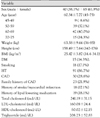Abstract
Background and Objectives
Pitavastatin, a recently approved synthetic 3-hydroxy-3-methylglutaryl coenzyme A (HMG-CoA) reductase inhibitor, is known to effectively treat hypercholesterolemia. The goal of this study was to investigate the efficacy and safety of pitavastatin in hyperlipidemic Korean patients with coronary risk factors.
Subjects and Methods
This was an 8-week, prospective, multicenter, open-label clinical trial. The study subjects were hyperlipidemic Korean patients (triglyceride <400 mg/dL and LDL-cholesterol >130 mg/dL, age; 45-75 years) with at least two coronary risk factors. After a 2-week wash out period, the eligible subjects were given 2 mg of pitavastatin once daily for 8 weeks. In the case of the patients with LDL-cholesterol ≥100 mg/dL after the first 4 weeks of treatment, the dose of pitavastatin was increased to 4 mg per day for the remaining 4 weeks.
Results
Of the 131 patients initially enrolled, 105 completed the study. Among the lipid profiles, the total cholesterol, triglyceride, and LDL-cholesterol levels showed a significant reduction with mean reduction rates of -30.66%, -23.92%, and -41.06%, respectively, after 8 weeks. Interestingly, the HDL-cholesterol level was significantly increased in the subjects with a low HDL-cholesterol level (HDL-cholesterol <40 mg/dL) after 8 weeks of therapy (35.28±4.38 mg/dL to 40.39±6.45 mg/dL, 15.9%, p=0.001). The proportions of patients who achieved the LDL-cholesterol goal of the National Cholesterol Education Program Adult Treatment Panel III were 72.5% (37/51), 93.6% (44/47), and 100.0% (7/7) for the patients with goals of 100 mg/dL, 130 mg/dL, and 160 mg/dL, respectively. Five patients had mild adverse drug events, such as fatigue, itching, myalgia, and anorexia. No significant abnormalities were detected in the laboratory tests, including the liver function test and creatinine kinase level.
Figures and Tables
Fig. 1
Serial changes of serum total cholesterol level from baseline to study end (n=105). *: p<0.001 compared with baseline (0 wk).

Fig. 2
Serial changes of serum LDL-cholesterol level from baseline to study end (n=109). *: p<0.001 compared with baseline (0 wk). LDL: low density lipoprotein.

Fig. 3
Serial changes of LDL/HDL-cholesterol ratio from baseline to study end (n=109). *: p<0.001 compared with baseline (0 wk). LDL: low density lipoprotein, HDL: high density lipoprotein.

References
1. Sever PS, Dahlof B, Poulter NR, et al. Prevention of coronary and stroke events with atorvastatin in hypertensive patients who have average or lower-than-average cholesterol concentrations, in the Anglo-Scandinavian Cardiac Outcomes Trial--Lipid Lowering Arm(ASCOT-LLA): a multicentre randomised controlled trial. Lancet. 2003. 361:1149–1158.
2. The Scandinavian Simvastatin Survival Study. Randomised trial of cholesterol lowering in 4444 patients with coronary heart disease. Lancet. 1994. 344:1383–1389.
3. Shepherd J, Cobbe SM, Ford I, et al. Prevention of coronary heart disease with pravastatin in men with hypercholesterolemia. West of Scotland Coronary Prevention Study Group. N Engl J Med. 1995. 333:1301–1307.
4. Jun JE. Cholesterol lowering therapy in coronary artery disease. Korean Circ J. 2001. 31:849–856.
5. Isley WL. Pitavastatin(NK-104), a new HMG-CoA reductase inhibitor. Drugs Today. 2001. 37:587–594.
6. Park S, Kang HJ, Rim SJ, et al. A randomized, open-label study to evaluate the efficacy and safety of pitavastatin compared with simvastatin in Korean patients with hypercholesterolemia. Clin Ther. 2005. 27:1074–1082.
7. Expert Panel on Detection, Evaluation, and Treatment of High Blood Cholesterol In Adults. Executive Summary of The Third Report of The National Cholesterol Education Program(NCEP) Expert Panel on Detection, Evaluation, And Treatment of High Blood Cholesterol In Adults(Adult Treatment Panel III). JAMA. 2001. 285:2486–2497.
8. Cannon CP, Braunwald E, McCabe CH, et al. Intensive versus moderate lipid lowering with statins after acute coronary syndromes. N Engl J Med. 2004. 350:1495–1504.
9. Bae JH. Multicenter clinical trial of atorvastatin in patients with hypercholesterolemia. Korean Circ J. 2001. 31:434–441.
10. LaRosa JC, Grundy SM, Waters DD, et al. Intensive lipid lowering with atorvastatin in patients with stable coronary disease. N Engl J Med. 2005. 352:1425–1435.
11. Grundy SM, Cleeman JI, Merz CN, et al. Implications of recent clinical trials for the National Cholesterol Education Program Adult Treatment Panel III guidelines. Circulation. 2004. 110:227–239.
12. Cannon CP, Steinberg BA, Murphy SA, Mega JL, Braunwald E. Meta-analysis of cardiovascular outcomes trials comparing intensive versus moderate statin therapy. J Am Coll Cardiol. 2006. 48:438–445.
13. Nissen SE, Nicholls SJ, Sipahi I, et al. Effect of very high-intensity statin therapy on regression of coronary atherosclerosis. JAMA. 2006. 295:1556–1565.
14. Nissen SE, Tuzcu EM, Schoenhagen P, et al. Effect of intensive compared with moderate lipid-lowering therapy on progression of coronary atherosclerosis: a randomized controlled trial. JAMA. 2004. 291:1071–1080.
15. Alsheikh-Ali AA, Ambrose MS, Kuvin JT, Karas RH. The safety of rosuvastatin as used in common clinical practice: a postmarketing analysis. Circulation. 2005. 111:3051–3057.
16. Grundy SM. The issue of statin safety: where do we stand? Circulation. 2005. 111:3016–3019.
17. Blasetto JW, Stein EA, Brown WV, Chitra R, Raza A. Efficacy of rosuvastatin compared with other statins at selected starting doses in hypercholesterolemic patients and in special population groups. Am J Cardiol. 2003. 91:3C–10C.
18. Kawano H, Yano K. Pravastatin decreases blood pressure in hypertensive and hypercholesterolemic patients receiving antihypertensive treatment. Circ J. 2006. 70:1116–1121.
19. Pelat M, Dessy C, Massion P, Desager JP, Feron O, Balligand JL. Rosuvastatin decreases caveolin-1 and improves nitric oxide-dependent heart rate and blood pressure variability in apolipoprotein E-/- mice in vivo. Circulation. 2003. 107:2480–2486.




 PDF
PDF ePub
ePub Citation
Citation Print
Print




 XML Download
XML Download